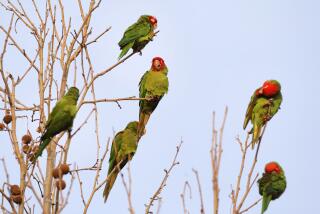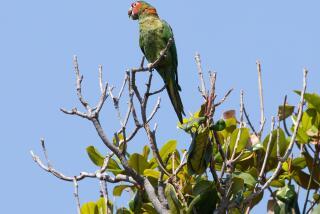Pigeon Coup : Couple’s Flock a Soaring Success in Disneyland Parade
- Share via
LA HABRA HEIGHTS — In an age of soft ware empires and mega-mergers, the Carpenters have built a nice little home business on a wing and a prayer. Mostly a wing.
*
They are the kingpins of the rent-a-homing-pigeon business. You say you need 100 or so white birds to take flight at your wedding? Dig up $375 and call the Carpenters.
Not exactly the kind of cash that would feather most people’s nests, but these days Mel and Margie Carpenter have hit the big time: Their white pigeons fly daily from the Lion King Celebration parade on Disneyland’s Main Street.
“It’s half hobby and half business,” said Carpenter, who added that his agreement with Walt Disney Co. does not allow him to discuss terms of his business with the park.
It’s just the latest in a series of high-profile gigs for the La Habra Heights couple’s flock of 600 white homing pigeons. They have flown at events ranging from Elizabeth Taylor’s most recent wedding at Michael Jackson’s estate to Easter sunrise services at the Hollywood Bowl.
The Carpenters say they owe their flock’s popularity to Peter Ueberroth, who, as chief of the 1984 Summer Olympics, realized that the Carpenters’ white pigeons would make fine stand-ins for doves at the opening and closing ceremonies.
Doves may symbolize peace, but they don’t have a homing instinct. “They just flutter up in the trees,” Margie Carpenter explained. Pigeons don’t symbolize anything, but at least you can get them back.
The Olympics performance generated a swarm of other offers. The next year, the birds made a stirring fly-by at Dodger Stadium during the visit of Pope John Paul II. Mel Carpenter still considers it to be the flock’s greatest moment. Instead of simply making a pass and winging away, the birds circled and circled again during the singing of hymns.
“It was really a religious experience for everyone there,” Carpenter said.
Since then, the Carpenters have relied strictly on word-of-mouth--or in this case, coo-of-beak--for new business. That’s how Disneyland and the Carpenters got together a few years back. Disneyland was looking for someone to take over the flock that it kept at the park for parades and shows.
When Disneyland decided to incorporate a pigeon release into the daily parade based on the hit animated movie “The Lion King,” the Carpenters were called upon to deliver up to 300 birds a day.
Mel Carpenter’s day starts at 4:30 a.m., when he rises to feed, medicate and otherwise care for the flock a few feet from his hillside home. He also shovels pigeon droppings, which he uses to fertilize his garden. He walks through the coop, inspecting every bird to make sure it is healthy before being put in boxes for the 14-mile trip to Disneyland.
Then he’s off to his regular job as a dentist, where the first patient is waiting for him at 8 a.m. Margie Carpenter, who works part-time as a dental hygienist, often is the one who hauls the homing pigeons to Disneyland in a pickup truck. They are kept cool with fans and placed in air-conditioned boxes in the floats. “We schooled the dancers on how to hold the birds,” Mel Carpenter said.
Park officials say they couldn’t be happier with the arrangement. “It’s been working real smooth, real well,” said Disneyland Production Manager Joey Michaels.
The parade has proven so popular that instead of wrapping up after Labor Day, it is scheduled to continue indefinitely.
Performers release the birds at the end of a dance number. They usually circle a couple of times to get their bearings and then wing home--about 10 1/2 miles as the pigeon flies. At speeds of more than 40 m.p.h., they usually arrive in a few minutes.
Most arrive home safely. Some don’t. Birds can crash into telephone poles or become a lunchtime snack for hovering hawks. Even in the coop, there’s the constant threat of invasion by critters such as raccoons or squirrels. Or a disease epidemic can start through the flock.
Mel Carpenter said he is careful to isolate birds that appear sick. He also performs surgery on birds that might have bumped into something as they flapped home.
“We work real hard to make sure they are happy here,” he said.
The Disneyland birds average 1 to 3 years of age, but the Carpenters still have some of the old-timers that flew in the 1984 Olympics.
Young birds can’t automatically find their way home. For a few weeks, they are released from the coop so they can circle and return. Then they are crated and driven to locations farther and farther from the coop.
To increase the strength and speed of their pigeons, the Carpenters breed different colors of racing pigeons into their white stock. It takes three generations for the birds to become pure white again.
Mel Carpenter, 52, said he learned the techniques of pigeon breeding as a boy growing up in Inglewood and raced the birds for years. In pigeon racing, owners release their birds up to 600 miles away and see which one arrives home the soonest.
He eventually gave up racing to concentrate on breeding his white flock. The Carpenters settled in La Habra Heights because residential lots are zoned for a minimum of one acre, and animals are allowed.
“When we bought this house, Mel went straight to the back yard” to plan his coop, Margie Carpenter said.
And for 19 years, the Carpenters have spent nearly every day in the back yard. After all, there’s no place like home--especially for a pigeon.
(BEGIN TEXT OF INFOBOX / INFOGRAPHIC)
Homing In on Pigeons
Ornithologists do not know exactly how or why homing pigeons return. But it is believed they navigate like humans, using the sun and other celestial bodies to determine position. Other factors include a keen sense of sight and hearing, a highly developed sensitivity to the Earth’s magnetic fields and strong bonds to mates and young. Some other pigeon facts:
* All in the family: Pigeons and doves belong to the same family of about 300 types of birds.
* Mistaken identity: Birds commonly seen in city parks are not homing pigeons; those are rock doves--often disparagingly referred to as “rats with wings.”
* Range: Worldwide, except polar regions and some oceanic islands.
* Speed: Up to 60 m.p.h. under good conditions.
* Distance: Most races are 100-600 miles, but homing pigeons have flown 1,000 miles in two days.
* News carriers: They brought back news of Caesar’s conquests and the results of early Olympic games. Until 1956, the Army kept flocks to carry messages.
Source: American Racing Pigeon Union, World Book Encyclopedia. Researched by JANICE L. JONES / Los Angeles Times
More to Read
Sign up for Essential California
The most important California stories and recommendations in your inbox every morning.
You may occasionally receive promotional content from the Los Angeles Times.













